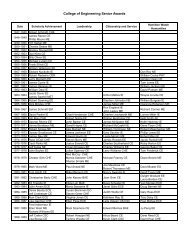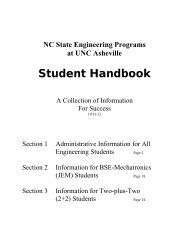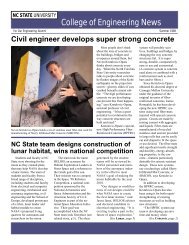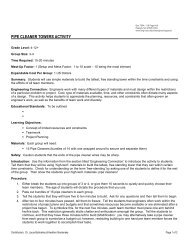FRONTLINE - College of Engineering - North Carolina State University
FRONTLINE - College of Engineering - North Carolina State University
FRONTLINE - College of Engineering - North Carolina State University
You also want an ePaper? Increase the reach of your titles
YUMPU automatically turns print PDFs into web optimized ePapers that Google loves.
design a modeling process that is highly specific. Using molec-<br />
ular modeling and computer-aided molecular design, we can<br />
manipulate the material properties to optimize performance.”<br />
Currently the team is working to design and produce micro-<br />
needles with a variety <strong>of</strong> specifications and modeling the pen-<br />
etration <strong>of</strong> the needles in skin to improve geometry and design.<br />
The designs are being tested and validated in the Biomechanics<br />
Laboratory at NC <strong>State</strong> with the help <strong>of</strong> Dr. Peter Mente, assis-<br />
tant pr<strong>of</strong>essor <strong>of</strong> biomedical engineering.<br />
“The conventional microneedles are not mass producible,”<br />
says Narayan. “What we are able to do is produce needles with<br />
unique geometrics tailored with optimal skin penetration and<br />
fracture resistance properties. Our goal is to be able to custom-<br />
ize and mass-produce these microneedles. Dr. Lee’s modeling<br />
work will help us find the most efficient and effective way to<br />
manufacture the devices using this new laser technique.”<br />
In the 2PIP process, laser pulses are delivered in femtosecond<br />
(one millionth <strong>of</strong> a nanosecond) pulses to break chemical<br />
bonds on photoinitiator molecules. These molecules react<br />
with the Ormocer® monomers to create radicalized polymol-<br />
ecules. (Monomers are single molecules that have the ability to<br />
combine with similar molecules in a process called polymeriza-<br />
tion.) The lasers are manipulated in three dimensions using a<br />
micropositioning system to create a three-dimensional micro-<br />
structure such as a microneedle. This new process opens the<br />
doors for the development <strong>of</strong> nano and micro devices that will<br />
have a wide variety <strong>of</strong> applications from painless injections to<br />
orthopedic, prosthetic and cardiovascular devices.<br />
“What initially attracted me to this type <strong>of</strong> research is the pos-<br />
sibility that we may someday have tiny machines that can func-<br />
tion within the human body to repair and heal the body,” said<br />
Lee. “There is beauty in the machine that can do what your<br />
hands cannot do and see what your eyes cannot see. This is the<br />
direction I see that engineering should go.”<br />
Lee’s vision <strong>of</strong> a micromachine that heals or helps the<br />
human body may not be that far-fetched. He and Narayan<br />
already envision that their modeling and fabrication<br />
process may one day develop a tiny device that can reside<br />
in the body <strong>of</strong> a diabetic and not only monitor blood<br />
sugar levels but also deliver proper doses <strong>of</strong> insulin. The<br />
device would combine the microneedles they are currently<br />
designing with a microelectromechanical system (MEMS)<br />
and a nanosensor that remains viable in the human body.<br />
Essentially the diabetic would no longer have to prick a<br />
finger, inject insulin or wear an external insulin pump.<br />
Materials with antimicrobial properties may be incorpo-<br />
rated so that the risk <strong>of</strong> infection, a serious concern for dia-<br />
betics, would be all but eliminated.<br />
“The tiny system that can go inside the body and make<br />
repairs will probably not be developed in my lifetime,” says<br />
Lee. “But it is satisfying to know that we are working in that<br />
direction.” �<br />
The two photon induced polymerization<br />
(2PIP) process can<br />
produce these microneedles<br />
(left and below) using Ormocer ® .<br />
(Images: courtesy Roger Narayan)<br />
1








